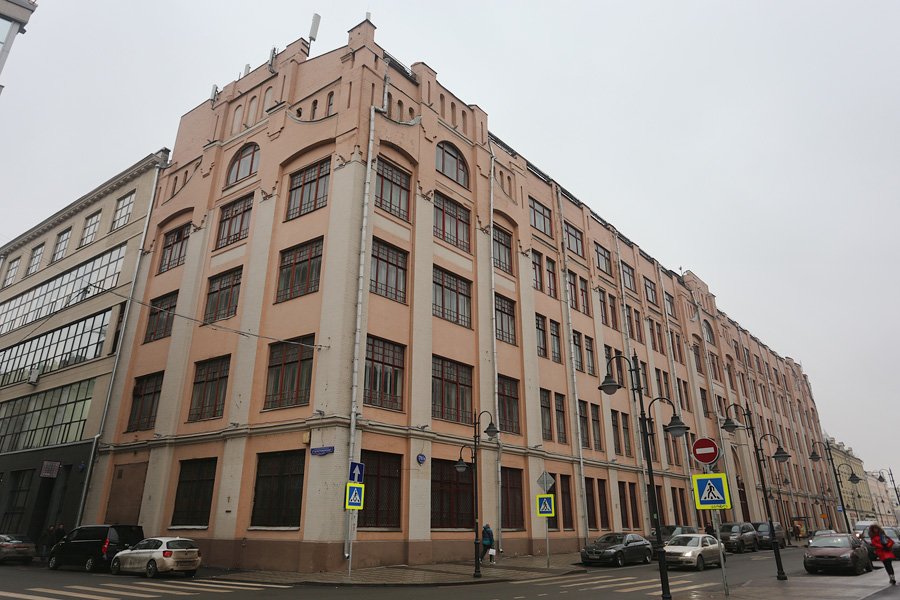Почти в самом конце Пятницкой улицы располагается огромное здание Сытинской типографии. Самый известный из дореволюционных российских издателей, Иван Дмитриевич Сытин родился в 1851 году в Костромской губернии. В 15 лет Иван Сытин приехал в Москву и устроился на работу в книжную лавку. Через десять лет, накопив денег, он покупает свою первую литографскую машину и открывает небольшую литографию на Варгунихиной горе. Сначала печатает лубочные картинки, очень популярные в народе. А во время русско-турецкой войны переходит на выпуск карт боевых действий. Постепенно он начинает расширять ассортимент, главным образом за счёт народных дешёвых книг. На Всероссийской промышленной выставке в 1882 году он получает бронзовую медаль за книгопечатную продукцию. В 1887 году Иван Дмитриевич приобретает обширное владение (№№ 71-73) на Пятницкой улице, и в 1903 году архитектор А. Э. Эрихсон при участии инженера В. Г. Шухова возводят для Сытина здание типографии.
Здание типографии частично располагается на месте владения, которое до 1834 года принадлежало титулярному советнику Николаю Фёдоровичу Островскому (южная часть , если смотреть с Пятницкой). Здесь в течение 14 лет жил знаменитый драматург Александр Островский.
Главный фасад строения с готическим входом и сложными фигурными аттиками с полукруглыми окнами прост, но производит большое впечатление. Переплёты многих окон сохранились с начала ХХ века. При этом необходимо учесть, что общий вид сооружения значительно испорчен надстройкой дополнительного этажа.
А через два года, в 1905 года, типография была сожжена. Первоначально руководителями начавшейся забастовки была арестована вся администрация, и под угрозой применения оружия был напечатан первый номер «Известий Советов рабочих депутатов», с оповещением населения о происходящем. В нём было заявлено, что Московский совет рабочих депутатов в союзе с социал-демократической партией и социалистами-революционерами постановил объявить в Москве всеобщую политическую стачку, чтобы перевести её в вооружённое восстание против царизма. В огне пожара, охватившего типографию, погибло всё оборудование, запасы бумаги и произошло частичное обрушение перекрытий.
Но уже через год Сытин восстановил производство. В этом историческом здании бывали Л.Н. Толстой, А.М. Горький, В.В. Маяковский, С.А. Есенин, который, кстати, работал некоторое время у Сытина корректором. После революции типографию национализировали и она стала носить название Первая Образцовая типография. Что интересно, сразу после Октябрьского переворота на общем собрании рабочих несколькими тысячами голосов был осуждён насильственный захват власти большевиками. Создать коммунистическую ячейку в типографии удалось только в начале 1920-х годов.
At first, he printed splint prints, which were very popular among the people at that time. Then he started to print geographical maps for battlefield during the Russian-Turkish war. Gradually, he began to expand its range, mainly due to the popular cheap books. At the All-Russia Exhibition in 1882, he received a bronze medal for typographic products. In 1887, Ivan Dmitrievich acquired extensive property at 71-73 Pyatnitskaya Street, and in 1903 the architect AE Erichson with the participation of the engineer Shukhov erected a building for Sytin’s print house.
The building is partially located on the property, which until 1834 belonged to the titular counselor Nikolai Fyodorovich Ostrovsky (southern part, when viewed from Pyatnitskaya street). Famous playwright Alexander Ostrovsky lived here for 14 years.
The main facade of the building with a Gothic entrance and complex sculpted attics with semicircular windows is simple, but makes a great impression. Binding many windows are preserved from the beginning of the twentieth century. At the same time, it is necessary to take into account that the general view of the structure is significantly damaged by the additional floor.
And two years later, in 1905, the print house was burned. Initially, the whole administration was arrested by the strike leaders. Then, "News of the Soviets of Workers' Deputies" published about what is happening. It stated that the Moscow Soviet of Workers' Deputies in alliance with the Social Democratic Party and the Socialist-Revolutionaries had decided to declare a general political strike in Moscow in order to start an armed uprising against the tsarist regime. In the fire the printing press were enveloped, all equipment, paper stocks were lost and a partial collapse of the floors occurred.
But Sytin restored production a year later. Tolstoy, Gorky, Mayakovsky, S.A. Esenin visited this historic building. After the revolution, the print house was nationalized and renamed into the “First exemplary print house”. What is interesting, the violent seizure of power by the Bolsheviks was convicted at a general meeting of workers by several thousand votes immediately after the October Revolution. They managed to create a communist cell in the print house only in the early 1920s.


















%20BEL_0521.jpg&w=1920&q=75)











